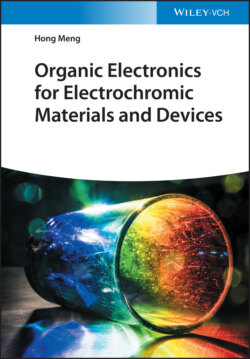Читать книгу Organic Electronics for Electrochromic Materials and Devices - Hong Meng - Страница 20
References
Оглавление1 1 Fletcher, S. (2015). The definition of electrochromism. Journal of Solid State Electrochemistry 19 (11): 3305–3308.
2 2 Camurlu, P. (2014). Polypyrrole derivatives for electrochromic applications. RSC Advances 4 (99): 55832–55845.
3 3 Wang, Z., Wang, X., Cong, S. et al. (2020). Fusing electrochromic technology with other advanced technologies: a new roadmap for future development. Materials Science & Engineering R: Reports 140.
4 4 Wu, W., Wang, M., Ma, J. et al. (2018). Electrochromic metal oxides: recent progress and prospect. Advanced Electronic Materials 4 (8).
5 5 Mortimer, R.J. (2011). Electrochromic materials. Annual Review of Materials Research 41 (1): 241–268.
6 6 Platt, J.R. (1961). Electrochromism, a possible change of color producible in dyes by an electric field. The Journal of Chemical Physics 34 (3): 862–863.
7 7 Hutchison, M.R. (1913). Electrographic display apparatus and method. US Patent 1,068,774, filed 29 July 1913.
8 8 Lehovec K. (1957). Photon modulation in semiconductors. US Patent 2,776,367, filed 1 January 1957.
9 9 Neff, V.D. (1978). Electrochemical oxidation and reduction of thin‐films of prussian blue. Journal of the Electrochemical Society 125 (6): 886–887.
10 10 Michaelis, L. and Hill, E.S. (1933). The viologen indicators. The Journal of General Physiology 16 (6): 859–873.
11 11 Schoot, C.J., Ponjee, J.J., van Dam, H.T. et al. (1973). New electrochromic memory display. Applied Physics Letters 23 (2): 64–65.
12 12 Garnier, F., Tourillon, G., Garzard, M., and Dubois, J.C. (1983). Organic conducting polymers derived from substituted thiophenes as electrochromic material. Journal of Electroanalytical Chemistry 148: 299–303.
13 13 Mengoli, G., Musiani, M.M., Schreck, B., and Zecchin, S. (1988). Electrochemical synthesis and properties of polycarbazole films in protic acid media. Journal of Electroanalytical Chemistry and Interfacial Electrochemistry 246 (1): 73–86.
14 14 Zheng, H.B., Lu, W., and Wang, Z.Y. (2001). Electrochemical and electrochromic properties of poly(ether naphthalimide)s and related model compounds. Polymer 42 (8): 3745–3750.
15 15 Oishi, Y., Takado, H., Yoneyama, M. et al. (1990). Preparation and properties of new aromatic polyamides from 4,4′‐diaminotriphenylamine and aromatic dicarboxylic acids. Journal of Polymer Science Part A: Polymer Chemistry 28 (7): 1763–1769.
16 16 Cheng, S.‐H., Hsiao, S.‐H., Su, T.‐H., and Liou, G.‐S. (2005). Novel aromatic poly(amine‐imide)s bearing a pendent triphenylamine group: synthesis, thermal, photophysical, electrochemical, and electrochromic characteristics. Macromolecules 38 (2): 307–316.
17 17 Arimoto, F.S. and Haven, A.C. (1955). Derivatives of dicyclopentadienyliron. Journal of the American Chemical Society 77 (23): 6295–6297.
18 18 Whittell, G.R. and Manners, I. (2007). Metallopolymers: new multifunctional materials. Advanced Materials 19 (21): 3439–3468.
19 19 Wade, C.R., Li, M., and Dincă, M. (2013). Facile deposition of multicolored electrochromic metal–organic framework thin films. Angewandte Chemie International Edition 52 (50): 13377–13381.
20 20 Hao, Q., Li, Z.‐J., Lu, C. et al. (2019). Oriented two‐dimensional covalent organic framework films for near‐infrared electrochromic application. Journal of the American Chemical Society 141 (50): 19831–19838.
21 21 Li, W., Ning, J., Yin, Y. et al. (2018). Thieno[3,2‐b]thiophene‐based conjugated copolymers for solution‐processable neutral black electrochromism. Polymer Chemistry 9 (47): 5608–5616.
22 22 Beaujuge, P.M. and Reynolds, J.R. (2010). Color control in π‐conjugated organic polymers for use in electrochromic devices. Chemical Reviews 110 (1): 268–320.
23 23 Jiang, M., Sun, Y., Ning, J. et al. (2020). Diphenyl sulfone based multicolored cathodically coloring electrochromic materials with high contrast. Organic Electronics 83: 105741.
24 24 Fred Schubert, E., Chapter 16. Human Eye Sensitivity and Photometric Quantities in Light‐Emitting Diodes, 2e. Cambridge University Press.
25 25 Kraft, A. (2018). Electrochromism: a fascinating branch of electrochemistry. ChemTexts 5 (1): 1–18.
26 26 Padilla, J., Seshadri, V., Filloramo, J. et al. (2007). High contrast solid‐state electrochromic devices from substituted 3,4‐propylenedioxythiophenes using the dual conjugated polymer approach. Synthetic Metals 157 (6–7): 261–268.
27 27 Hsiao, S.‐H. and Lin, S.‐W. (2016). Electrochemical synthesis of electrochromic polycarbazole films from N‐phenyl‐3,6‐bis(N‐carbazolyl)carbazoles. Polymer Chemistry 7 (1): 198–211.
28 28 Hassab, S., Shen, D.E., Österholm, A.M. et al. (2018). A new standard method to calculate electrochromic switching time. Solar Energy Materials and Solar Cells 185: 54–60. https://doi.org/10.1016/j.solmat.2018.04.031.
29 29 Fabretto, M., Vaithianathan, T., Hall, C. et al. (2008). Faradaic charge corrected colouration efficiency measurements for electrochromic devices. Electrochimica Acta 53 (5): 2250–2257.
30 30 Wei, Y., Zhou, J., Zheng, J., and Xu, C. (2015). Improved stability of electrochromic devices using Ti‐doped V2O5 film. Electrochimica Acta 166: 277–284.
31 31 Lampert, C.M., Agrawal, A., Baertlien, C., and Nagai, J. (1999). Durability evaluation of electrochromic devices – an industry perspective. Solar Energy Materials and Solar Cells 56 (3): 449–463.
